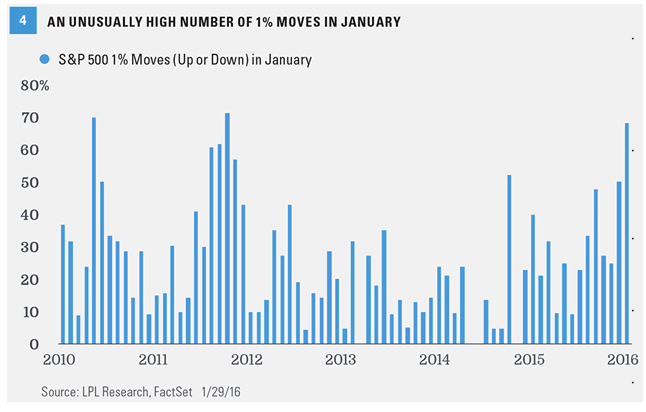· Few bulls remaining. Extreme bearish sentiment has reached levels that have tended to accompany market bottoms.
· More reasonable stock valuations following the latest correction. Valuations for the S&P 500, at 15 times forward earnings estimates and 16 times trailing earnings, are in-line with long-term averages and especially attractive considering low interest rate levels. Yields are also attractive at 2.3% for the S&P 500 compared to a 10-year Treasury yield at 1.9%.
· Low probability of recession. Despite lackluster gross domestic product (GDP) growth in the fourth quarter of 2015, we continue to see the probability that the U.S. economy enters recession in 2016 as low, potentially 15– 20% based on the economic data.
· Earnings acceleration is still likely in 2016. Our view and the consensus view are still calling for mid-single-digit earnings gains in 2016 as the energy and U.S. dollar drags abate. We do not believe the diversified broad market index needs much help from improved global growth to achieve these gains, despite the lackluster start to fourth quarter 2015 earnings season.
Fed communication may help. Federal Reserve (Fed) Chair Janet Yellen’s House testimony on February 10 may help stocks if the Fed’s communicated timetable for rate hikes this year (four) moves closer to the market’s view (zero to one).
· Potential for more stimulus from China and the Eurozone. The market reacted very positively to Friday’s (January 29, 2016) news that Japan was moving to a negative interest rate policy. Europe and China may follow with additional moves to help the market’s perception of future growth.
However, we still have some concerns that suggest a market tug-of-war in the near term:
· Alternatively, Fed communication may not help. Chair Yellen did not help assuage the market’s fears of an overly aggressive Fed or global growth risks in the Federal Open Market Committee (FOMC) statement on January 27, 2016, and may not do so when she speaks on February 10. With four hikes still on the table, the risk of a policy mistake and additional stock market volatility is higher.
· Oil markets have made very little progress toward balancing supply with demand. Reports of a Saudi Arabia–Russia agreement to cut oil production appear to lack substance. Oil markets have contributed to fears of a disruption in credit markets that may contribute to choking off financing even to non-energy companies.
· China may need to further devalue its currency. Until that happens, or unless China somehow convinces the market it doesn’t need to take such action (unlikely), we see risks of another potential downdraft in the U.S. stock market. China’s currency devaluation contributed to the stock market correction in August 2015.









